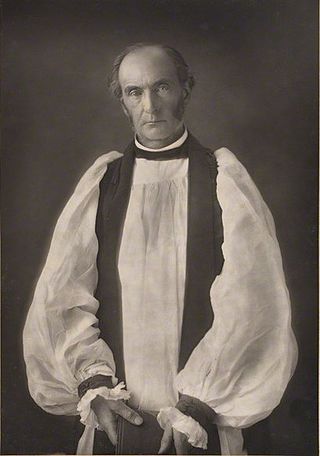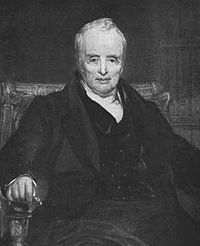
The title Duke of Abercorn is a title in the Peerage of Ireland. It was created in 1868 and bestowed upon James Hamilton, 2nd Marquess of Abercorn. Although the Dukedom is in the Peerage of Ireland, it refers to Abercorn, West Lothian, and the Duke also bears four titles in the Peerage of Scotland and two in the Peerage of Great Britain, and is one of only three peers who have titles in those three peerages. The Duke of Abercorn also claims the French title of Duke of Châtellerault, created in 1548.

Marquess of Waterford is a title in the Peerage of Ireland and the premier marquessate in that peerage. It was created in 1789 for the Anglo-Irish politician George Beresford, 2nd Earl of Tyrone. The title is presently held by Henry Beresford, 9th Marquess of Waterford.

Marquess of Northampton is a title that has been created twice, firstly in the Peerage of England (1547), then secondly in the Peerage of the United Kingdom (1812). The current holder of this title is Spencer Compton, 7th Marquess of Northampton.

Marquess of Londonderry, of the County of Londonderry, is a title in the Peerage of Ireland.

Marquess Conyngham, of the County of Donegal, is a title in the Peerage of Ireland. It was created in 1816 for Henry Conyngham, 1st Earl Conyngham. He was the great-nephew of another Henry Conyngham, 1st Earl Conyngham, a member of a family of Scottish descent which had settled during the Plantation of Ulster in County Donegal in Ireland in the early 17th century. The 'founder' of the dynasty in Ireland was The Very Rev. Dr. Alexander Cunningham, Dean of Raphoe. The earlier Henry was a member of both the Irish House of Commons and the British House of Commons and served as Vice-Admiral of Ulster and as Governor of the counties of Donegal and Londonderry. In 1753 he was raised to the Peerage of Ireland as Baron Conyngham, of Mount Charles in the County of Donegal, and in 1756 he was created Viscount Conyngham, in Ireland, also in the Peerage of Ireland. In 1781 he was made Baron Conyngham, of Mount Charles in the County of Donegal, with remainder to his nephew Francis Burton, and Earl Conyngham, of Mount Charles in the County of Donegal, which like the creations of 1753 and 1756 was created with normal remainder to the heirs male of his body. The latter titles were also in the Peerage of Ireland. Lord Conyngham was childless and on his death in 1781 the barony of 1753, the viscountcy and earldom became extinct while he was succeeded in the barony of 1781 according to the special remainder by his aforementioned nephew Francis. He was the eldest son of Mary, sister of the first Earl Conyngham, by her husband Francis Burton. The new 2nd Baron Conyngham, who had earlier represented Killybegs and County Clare in the Irish House of Commons, assumed by Royal licence the surname and arms of Conyngham on succeeding to the titles.

Earl Cowley is a title in the Peerage of the United Kingdom. It was created in 1857 for the diplomat Henry Wellesley, 2nd Baron Cowley. He was Ambassador to France from 1852 to 1867. He was made Viscount Dangan, of Dangan in the County of Meath, at the same time as he was given the earldom. This title is also in the Peerage of the United Kingdom. Lord Cowley was the eldest son of Henry Wellesley, 1st Baron Cowley, who like his son served as Ambassador to France. In 1828 he was created Baron Cowley, of Wellesley in the County of Somerset, in the Peerage of the United Kingdom. A member of the prominent Wellesley family, Cowley was the fifth and youngest son of Garret Wellesley, 1st Earl of Mornington, and the younger brother of Arthur Wellesley, 1st Duke of Wellington, and Richard Wellesley, 1st Marquess Wellesley.

Baron Londesborough, of Londesborough in the East Riding of the County of York, is a title in the Peerage of the United Kingdom. It was created in 1850 for the diplomat and Whig politician Lord Albert Denison. He was the third son of Henry Conyngham, 1st Marquess Conyngham, and his wife Elizabeth Denison. Born Albert Denison Conyngham, he assumed by royal licence the surname of Denison in lieu of Conyngham in 1849 on inheriting the vast fortune of his maternal uncle William Joseph Denison (1770–1849). Before his elevation to the peerage, Denison had represented Canterbury in Parliament. His eldest son, the second Baron, sat as a Liberal Member of Parliament for Beverley and Scarborough. In 1887 he was created Viscount Raincliffe, of Raincliffe in the North Riding of the County of York, and Earl of Londesborough, in the County of York. These titles were also in the Peerage of the United Kingdom. However, the viscountcy and earldom became extinct on the death of his grandson, the fourth Earl, in 1937.

Earl or Lord of Clanricarde is a title that has been created twice in the Peerage of Ireland, first in 1543 and again in 1800. The former creation became extinct in 1916 while the 1800 creation is extant and held by the Marquess of Sligo since 1916.

Earl of Bridgewater was a title that has been created twice in the Peerage of England, once for the Daubeny family (1538) and once for the Egerton family (1617). From 1720 to 1803, the Earls of Bridgewater also held the title of Duke of Bridgewater. The 3rd Duke of Bridgewater is famously known as the "Canal Duke", for his creation of a series of canals in North West England.

William Conyngham Plunket, 1st Baron Plunket, PC (Ire), QC was an Irish politician and lawyer. After gaining public notoriety as the prosecutor in the treason trial of Robert Emmet in 1803, he rose rapidly in government service. He become Lord Chancellor of Ireland in 1830 and served, with a brief interruption, in that post until his retirement in 1841.

William Conyngham Plunket, 4th Baron Plunket was Dean of Christ Church Cathedral and Archbishop of Dublin in the Church of Ireland.

Earl Fitzwilliam was a title in both the Peerage of Ireland and the Peerage of Great Britain held by the head of the Fitzwilliam family.

George Gordon, 9th Marquess of Huntly,, styled Lord Strathavon until 1795 and known as The Earl of Aboyne from 1795 to 1836, was a Scottish peer and soldier.
Plunkett is an Irish surname derived from the Gaelic Ó Pluingceid. It is associated with Ireland, and possibly of Norse or Norman origin; it may be spelled O'Plunket, Plunket, Plunkit, Plunkitt, Plonkit, Plonkitt, Plonket, Plonkett, or Ó Plunceid, and may refer to:

Patrick Terence William Span Plunket, 7th Baron Plunket,, was Equerry to Queen Elizabeth II and Deputy Master of the Household of the Royal Household (1954–1975).
Captain Robin Rathmore Plunket, 8th Baron Plunket, was a descendant of prominent Irish lawyer and Whig politician William Conyngham Plunket for whom the Peerage of the United Kingdom was created in 1827.

Terence Conyngham Plunket, 6th Baron Plunket, was the son of The 5th Baron Plunket and Lady Victoria Alexandrina Hamilton-Temple-Blackwood.
John Span Plunket, 3rd Baron Plunket of Newtown, County Cork was an Irish peer and Queen's Counsel. He was the second son of William Plunket, 1st Baron Plunket, and Catherine MacAusland. He succeeded his brother Thomas Plunket, 2nd Baron Plunket in 1866. He married Charlotte, daughter of the eminent judge Charles Kendal Bushe and his wife Anne (Nancy) Crampton.

Lady Louisa Lilias (Lelias) Plunket Greene was an Irish author of children's stories writing under the names: Louisa Lilias Greene, Louisa Lilias Plunket, Baroness Greene, R. J. Greene, Louisa Lelias Greene.
Alfred Nathaniel Holden Curzon, 4th Baron Curzon, was a British aristocrat and clergyman. He was the father of George Curzon, 1st Marquess Curzon of Kedleston, who was the Conservative Viceroy of India and British Foreign Secretary.













